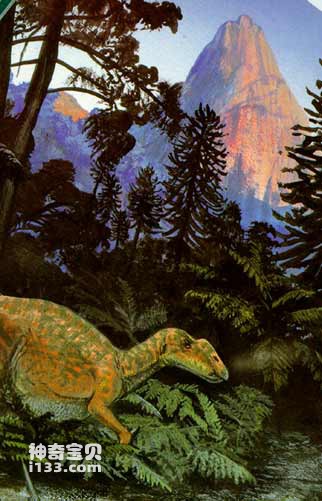When the ferns of the Paleozoic Era formed the first primeval forests on earth, gymnosperms, which were more advanced than ferns, had quietly appeared in the late Devonian period. But at that time, the climate on Earth was warm and humid, ferns developed more smoothly, and gymnosperms were not yet able to gain advantage. In the late Permian, the climate became cooler and drier. Ferns could not adapt well to this new environment and gradually withdrew from the center stage of the plant kingdom. Gymnosperms began to exert their potential advantages and gained great popularity. developed and continued its prosperity until the late Cretaceous. It can be said that the vegetation in the reptile kingdom is characterized by gymnosperms.

Reptile Kingdom Vegetation Landscape
Gymnosperms are the earliest species on earth that use seeds for sexual reproduction. Algae and ferns that appeared before that all used spores for sexual reproduction. The superiority of gymnosperms is mainly reflected in their propagation by seeds.
Before the late Permian, ferns were able to reproduce in large numbers mainly because their sporophytes produced a large number of spores, which were scattered everywhere. Under warm and humid climate conditions, they could easily germinate into gametophytes; gametophytes lived independently in the water. With the help of fertilization, the zygote is fertilized to form a zygote, which germinates to form a new generation of sporophytes. However, under dry climate conditions, it is difficult for spores to germinate into gametophytes, and the germinated gametophytes are not easy to survive; in particular, fertilization cannot occur without water, which prevents fern reproduction from proceeding normally.
The gametophyte of gymnosperms does not develop independently from the sporophyte, but is protected by the mother; its fertilization does not require water as a medium, but uses dry fertilization. The fertilized egg develops into an embryo in the mother's body, forming a seed, and then separates from the mother's body. If adverse conditions are encountered at this time, the seeds may not germinate immediately, but they will continue to maintain vitality. When conditions are suitable, they will germinate into new plants. Therefore, the ability of gymnosperms to preserve and perpetuate the species is greatly enhanced.
Gymnosperms originated from plants that have both true fern and gymnosperm characteristics, that is, pregymnosperms, including ancient ferns and sturgeon ferns. The ancient fern lived in the Late Devonian more than 400 million years ago, and its main stem is 1.6 meters thick and 35 meters high. Halberdifera ferns lived from the Middle Devonian to the Late Devonian. They are divided into main stems and branches, which can be more than 10 meters high.

Cycad leaf fossil
In the Late Devonian, a branch of tree-like plants evolved from the pregymnosperms. Most of its leaves are pinnately compound leaves with a typical fern leaf shape, but they contain seeds, so it is called a seed fern. Although the seed fern has seeds, it does not have an embryo; although it has pollen grains, it does not have pollen tubes, so it has no flowers. On the one hand, this proves that seed ferns are the precursors of seed plants in their primitive state, and on the other hand, it also proves that seeds appear earlier than flowers and fruits in plant phylogeny.
On this basis, gymnosperms differentiated into two major categories, cycads and conifers, and developed vigorously in the Mesozoic Era, becoming dominant members of the vegetation in the reptile kingdom.
animal tags: Gymnosperms
We created this article in conjunction with AI technology, then made sure it was fact-checked and edited by a Animals Top editor.